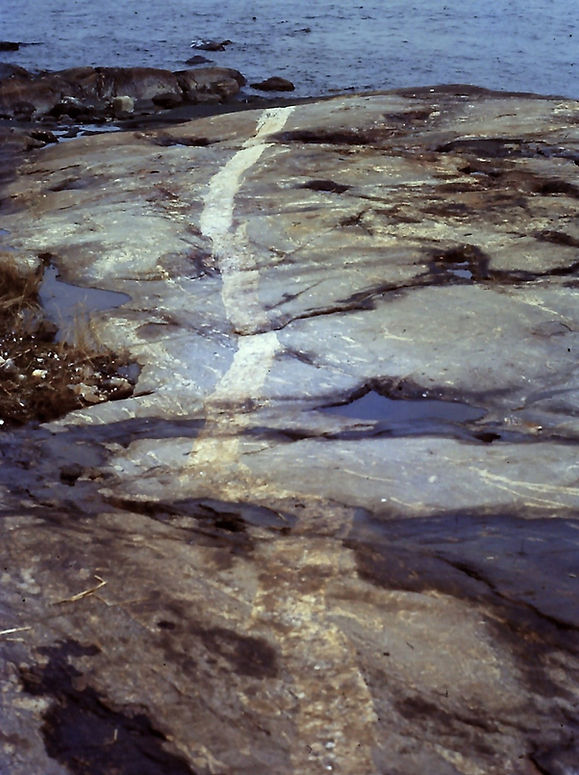
METAMORPHICS OF MANHATTAN PRONG - NEW ENGLAND UPLAND
.
FIELD TRIP STOPS – VARIOUS EXPOSURES OF METAMORPHIC ROCKS FOUND IN UPPER BRONX-LOWER WESTCHESTER COUNTIES
LOCATION: Just west of the Hudson River in the upper Bronx and lower Westchester Counties of New York.
GEOLOGIC FEATURES: Gneiss, Schist, Amphibolite, Pegmatites; Ductile Flow; Flow-Folds; Glacial Striations.
DESCRIPTION: Rocks of the outcrops shown here are Metamorphic Medium to High Grade Gneiss, Amphibolites, Schists, and Pegmatites. Rocks have been subsequently folded. Metamorphism is thought to be predominantly lower Paleozoic (Taconian Orogeny) and perhaps slightly younger in age. In places, evidence of glaciers is present as striations on the bedrock surface.
STUDENT QUESTIONS:
(1) What is metamorphism?
(2) What kind of rocks are subject to metamorphism over time?
(3) What is meant by High-Grade Metamorphism vs. Low-Grade?
(4) What is foliation and how does it occur?
(5) What can you interpret if you see foliation that is itself folded?
(6) Explain the meaning of Ductile Flow and Plastic Flow.
(7) What are the characteristics of a Pegmatite Dike?
(8) How does an Amphibolite differ from a Gneiss?
(9) How are glacial striations embedded onto the surface of a rock?
(10) CHALLENGE: Construct a drawing of a metamorphic rock outcrop surface showing evidence of three stages of metamorphism and then explain the sequence of events that had to have occurred over geologic time to account for the outcrop’s fabric.
(11) CHALLENGE: How are Pegmatites formed and why are their crystals commonly of an unusual size?
(12) CHALLENGE: Why are gemstones and other rare minerals often associated with Pegmatites?
SELECTED REFERENCES:
-Brock, P.C. and P.W.G. Brock. 2001. Field Guide for Long Island Geologists Field Trip, Oct. 27, 2001. School of Earth and Environmental Sciences, Queens College, Flushing N.Y. 2001.
PHOTOS:
(ColorChange).jpg)
Figure 1 - Folding of previously formed gneiss (light) and amphibolite (dark). Note the smaller folds in the outer (upper) part of the gneiss, perhaps due to shearing forces occurring during the largeer scale folding.
(ChangeColor).jpg)
Figure 2 - Fold similar to that seen in Figure 1 above.
(ColorChange).jpg)
Figure 3 - Folding of veins within gneiss possibly due to ductile flow and shear forces.
(ColorChange).jpg)
Figure 4 - A dike of granitic material appears to have been emplaced at an angle to the foliation sometime after the formation of the gneiss. A close-up of this dike is seen in the figure below.
(ChangeColor).jpg)
Figure 5 - Here a granitic dike has been injected through the foliation of the gneiss. Within the dike, there appears to be another direction of foliation that is perpendicular to its length suggesting a later episode of metamorphism. .
(ChangeColor).jpg)
Figure 6 - Glacial striations across the weathered surface of gneiss.
(ChangeColor).jpg)
Figure 7 - Predominant amphibolites that have been folded.
(ChangeColor).jpg)
Figure 8 - Intrusion of coarse-grained Pegmatite Dike into surrounding amphibolite.
(ColorChane).jpg)
Figure 9 - Highly folded migmatitic gneiss.
(ChangedColor).jpg)
Figure 10 - Large exposure of mixed metamorphic rock types.